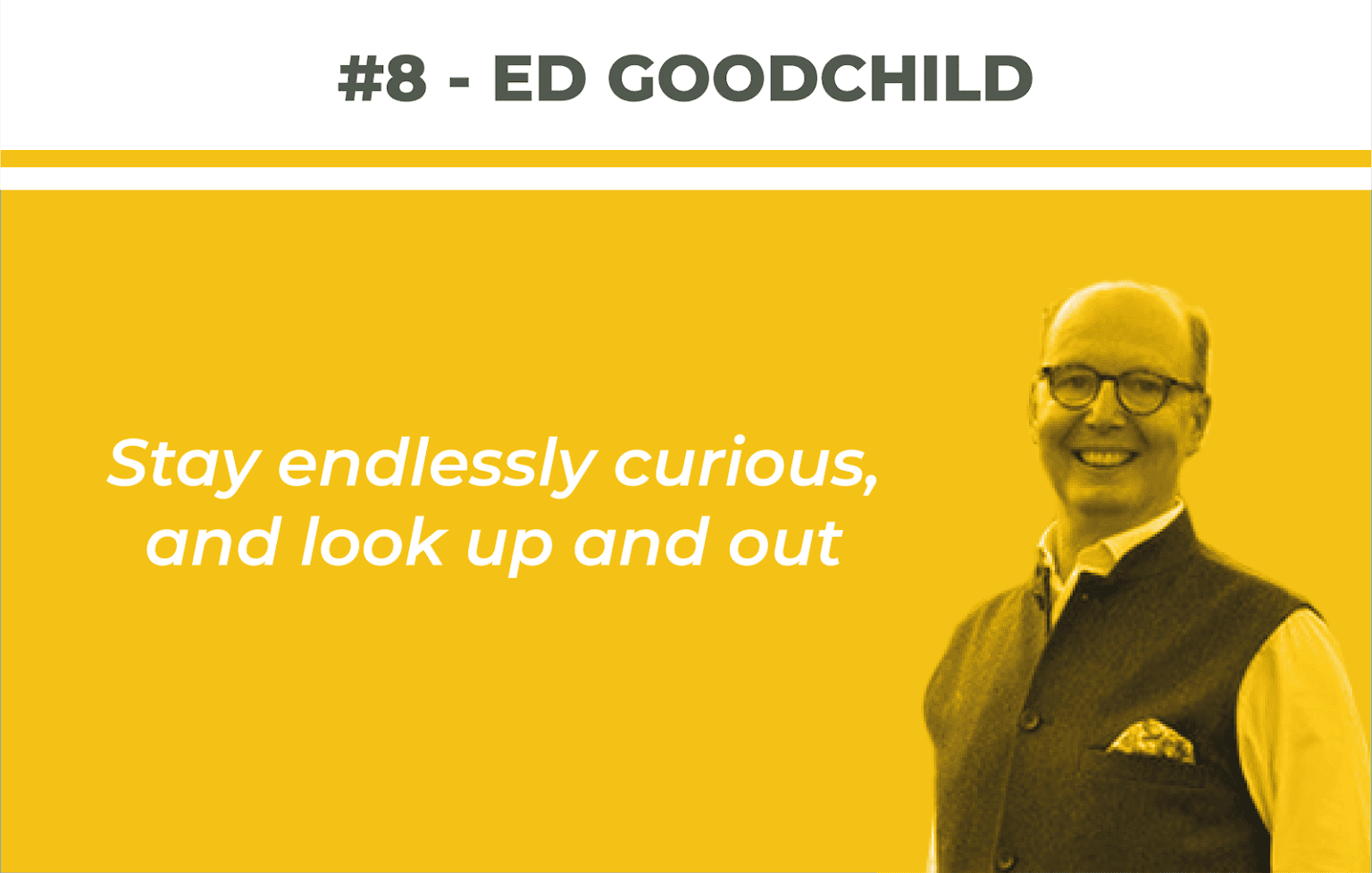Lexi Radcliffe-Hart
At his heart, Edward Goodchild is an enthusiastic innovator and perennial entrepreneur. On top of building the Zendht Venture Studio, he is an independent adviser, board chair, forum moderator and charity trustee.
Lexi caught up with Ed on our podcast series PortfolioCast to discuss staying endlessly curious, keeping kindness at the heart of your actions, how to determine your own narrative, start with an idea, and willingly embrace failure.
Q: Your love for innovation is a clear driver in the work that you do with Zendt. Where was that passion first formulated?
A: Well, it’s interesting, you should ask because I think if you’d asked either my parents, or my school masters, or indeed, my friends, when I was in my 20s, you would have never marked me down for doing any of this. I have to give away an age now, I’m now in my mid 50s, and it started when really, it was probably a bit of a midlife crisis, in my mid 40s. And I’ve been an advisor for a long time. And the bit that I found really interesting about being an advisor was, here are the life stories of the people that I was advising private clients, they were all entrepreneurs, they’d all typically started with zero and have made a significant amount of capital. And I started thinking, well, if they can do it, I’ve got these sort of connections and advantages, well, then surely I can do it. So that’s what I did.
Q: It’s interesting that you say, going back towards school, you definitely wouldn’t have been seen to do these sorts of things. But you’ve definitely got a clear appetite for learning. You mentioned that you have been an advisor, you’re a chartered wealth manager, you’ve got your CISI fellowship. And most recently, you’ve just this year gained your Chartered Institute of Marketing fellowship. How has all of these different educational avenues helped you build your portfolio career as it stands today?
A: The reason it worked, or the reason I pursued these different channels, is it’s only relatively recently – in fact having a portfolio actually finally gives it some sort of overall coherence. Because before I’ve done a whole series of different jobs in lots of different arenas, and therefore I’ve sought to be qualified in whatever I’ve been doing. And it’s now that I knit it all together.
I call it my venture studio, because I’ve got a number of different businesses, but you could equally describe it as a portfolio of different interests. And it’s being able to be open minded to picking out new knowledge about lots of different things.
I often talk about reach and range and scope and opportunity. But really, it’s about looking up and out. And education is just part of it. I suppose I’m endlessly curious, and I follow things or get interested in things or just develop passions about things.
That curiosity definitely drives us. To get somebody to pay you to do something, you need to have sufficient information, you need to have sufficient experience, which is why probably coming at it a bit later in life rather than kind of straight out of uni probably makes it easier. But people come to ask your advice because they don’t know the answer.
But it doesn’t mean you need to know absolutely everything about everything. And I think it’s the fear of thinking there are gaps in your knowledge that hold people back from doing multiple things or taking the big brave step. I think it was Branson who said if your plans or your ideas don’t frighten you, then they’re not big enough.
I always have a little bit of nervous anticipation. I think one of the characteristics, and I know that myself, you have to be somebody who is sort of permanently fidgeting, you’re always after new things or kind of wanting to look around the corner or look over the wall. You have to be slightly nosy about life in general.
I actually don’t think that everybody is full of ideas, but if you like lots of things, I think you can learn to have ideas. I don’t think it’s that some people just have an innate right to have the ideas and other people don’t. I think you can nurture and encourage it and learn the behaviours and if you hang out with the right people, you go look for it in the right places. And then guess what? If you’re open minded to it, then you begin to run with it.

Q: We often talk about balance in these interviews. But what I’d really love to know more about is how you make the connection between all the things that you do, and how that benefits you and the people that you’re working with, and others?
A: Firstly, I push back against this whole idea about work/life balance. The way that I look out the window, as it were, is I’ve got a life. And life is more interesting when it’s got some complexity, or it’s got some narrative around it, or it’s got some extra interest rather than being kind of monolithic, just doing one thing.
I’m a bit of a sucker for joining things. And that’s probably because I’ve never been a sportsman. I’ve got a background of joining membership organisations and wanted to be kind of an enthusiast about things. If you do that, and you’re open minded, you meet other people doing other things, and then how they relate, I suppose the way that they glue it together. And it’s always a bit imperfect. There’s no sort of mosaic, there are very few hard lines. There are lots of dotted lines and connections.
Life’s pretty good if you go around being helpful and are, broadly speaking, kind to people. And if you are broadly speaking kind, if somebody needs a helping hand, you help them, then you suddenly find that actually other people help you.
I actually view this as a safety net. Integrity is often viewed as how someone behaves when nobody else is looking. But if you try and just be a reasonable human being, it’s amazing how many other people will then treat you that way. But then he is actually really the glue that sticks it together. Linking things and people together will cost you nothing. You try to help somebody else, you create goodwill… And that’s what makes the world go round.
Q: There’s many entrepreneurial professionals out there. We’re definitely seeing them come out of the woodwork even more now so that people are facing furlough or redundancy etc. And who are looking to a portfolio career as a springboard into starting their own businesses. What advice would you give to somebody who is on this path?
A: I do have three bits of advice. The first one is about the isolation factor. I’ve worked in large organisations and one of the things that is difficult when you step off on your own is, you’re on your own. So the advice there is you want to create, pretty quickly, a little black book of technical people who can help you get stuff done.
The second one is another one requires recognition in your own headspace: nobody really cares what you’ve done before. So you need to develop your own narrative, because that’s what people will remember. You want people to be talking about you, so you better set your own story. Because otherwise, it’s just a sort of kind of random walk in the park.

I set up my first business when I was made redundant. So I was sitting nicely in a house and two kids in school, then I was just sitting looking at a box of possessions. I didn’t see it coming, by the way. So that changes your risk appetite, because you now have the scope of starting something out. And I was fortunate that there was a redundancy payment.
So that gives you a bit of money to start with, that takes off the immediate pressure, but I was always kind of a bit embarrassed about that. But then you realise after a few years that lots and lots of people who’ve set up companies quite often the starting point is facing redundancy, and people who’ve gone on to set up really successful big companies are quite open about it, which is part of the reason I’m now talking about it.
Following this first bit of advice is how I was always under the impression you needed to have a really detailed business plan, you needed to have everything topped and tailed, and everything to the state of perfection. Back to an old military adage of the first casualty of war is the plan.
I think with this sort of agile working, you need to have a sense of direction, to know what you want to try and achieve, and then break it down into the various steps to try and get there. But you need it to be kind of fluid. Pandemics certainly prove this, life just throws a whole tonne of curveballs at you, even when the world’s being well behaved.
The differentiator of a successful entrepreneur, or somebody with a portfolio career, is the ability to be able to cope with that uncertainty. One of the things I’ve said a lot to people, and it applies to me is, you’re never going to have a day when your jobs list, your task lists, you’re going to have ticked everything off. So if your criteria for being able to walk away from your desk, have a good night’s sleep, go out for supper, with the thought of how you’ve got a completely clear desk, you’ll be chained to your desk for perpetuity and never get away. Therefore the skill, which often isn’t the case in very large organisations, is being pretty brutal about prioritising. But only you can know what really needs to be done and have a very clear identity about where you want to be. And the struggle, and I think The Portfolio Collective has been really cool about this, is helping people work out what their goal should be because otherwise, it’s just a bit of a random walk.
And it might work and it might not but I’m a bit too much of a control freak. I like to know. It’s a bit like Sat Nav, you have a stab in the postcode, you may get lost on the way and you change the route and all the other stuff. But if you don’t have this clear vision, then it’s hard.
Q: Yeah, knowing where you’re heading is definitely a helpful starting place. As you say it’s a big part of what we do. And it’s a big part of how we start our Catapult course, for example, just getting people to really focus and often people haven’t taken the time to do that. And it might be because they haven’t been allowed the time to do it. How have you approached starting new businesses? You’ve started many, and you continue to work with many, how do you go about thinking, Okay, is this a good idea or a bad idea?
A: Well, I have a very simple process, because that’s the sort of way I work. So the first one is, you just have to have the idea. You don’t need to have solved nuclear fusion with this, it is just an idea.
Then I normally write what I would refer to as a scoping paper. So get some thoughts down on paper, normally a couple of sides of A4, bash it out. Don’t worry too much about syntax, just bash it out, and then move it around, then I normally try and literally sketch it out as a picture. A Mind Map that allows you to work out how the different bits will hold on together. You go through “Well, if I do this, I could do that. Or there’s a dotted line. Oh, I know someone who does that.” So you’re beginning to create a kind of an ecosystem around it.
Then typically I go look for people who can help me. They might be employees, they might be collaborators, they might be freelancers. And that’s normally done on a basic skills matrix. I know where I want to go, these are the skills I need. These are things I definitely don’t know about. It’s a bit of self awareness about if it is much more efficient if somebody else does it.
Then you’ve got to try and scoop those people up to your idea. So that’s your first pitch. Because if all the people you approach say “nah”, well, then you need to go back at the office, or the back bedroom, scratch your head and think, “Well, okay, maybe it wasn’t quite so cool”, but there’s an iterative process.
But as long as they don’t laugh you out completely, then there’s normally the part about trying to find some money. You’ve basically got two options, your own back pocket or somebody else’s back pocket. There’s always a bit of tension about that.
And of course, the amount of money that you have then determines the path that you can take, and 10,000 different models of doing that. I have generally gone the bootstrapping model, because I’ve been enthusiastic about what I want to do. And I’d rather just get on with it.
Because the really ugly side of fundraising is you go and talk to 100 people, and 95 of those people will tell you, you’re wrong. misplaced, somebody else is doing it. Because you got to find the five that will back you.
My advice is do it bootstrap because you don’t get diluted. You don’t have the problem of tonnes of people telling you your idea is rubbish. Now there’s a difference between genuine feedback from people who want to engage with you. When you’re out being the supplicant wanting money, it gets really soul destroying. So if you can avoid just going and seeing them at all, then my advice is just skirt around it and try to work out a different way.
Q: We talk a lot about success and what it means. But what failures have helped you along your way? And do you see them as failures anymore?
A: Oh the way is littered with failure. I can’t tell you the number of things I’ve been massively unsuccessful in and all sorts of things you thought were getting a bit brighter here and had ended up in cul de sacs. Through nobody’s particular fault, they just have.
But this is this iterative process, the risk of doing it in startup land, is it all tends to be a bit public. But you can’t do it all in the laboratory. You just have to get out and go and do it. Yeah, no, I think you have to willingly embrace failure. And also don’t let it do your head in, it is just part of it. In fact, I would contend that the measure of an entrepreneur is how you deal with failure.
Listen to the whole conversation on Episode 8 of PorfolioCast:
Think this sounds like the right path for you? Come along to our monthly Community Welcome Call for new members to find out what a portfolio career could look like and how The Portfolio Collective can help you take those first steps towards professional success – and don’t forget to connect with our community!




2 responses to “Portfolio Journey Series: Ed Goodchild”
Really enjoyed this Ed thanks. Helped me look at all the things I’m doing and see similar paths. Happy Christmas
You are a true entrepreneur Ed – great philosophy on career and life